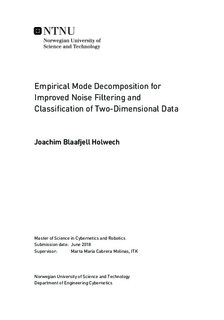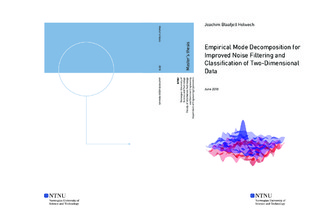| dc.description.abstract | This thesis studies the use of Empirical Mode Decomposition (EMD) applied to two dimensional data and the application of this method to filter noise from images. Mode Mixing Separation (MMS) is presented and implemented as a technique for reducing mode mixing, which is a common problem that occurs with the usage of EMD. A new filter is also introduced, which combines theory from both adaptive filters and EMD in an attempt to improve the noise filtering even further. In total, three types of EMD based filters are presented in this thesis:
- A filter based on EMD.
- A filter based on EMD with MMS.
- An adaptive filter based on EMD with MMS.
The filters are tested on three specific use cases where noise filtering could be valuable. The first test is based on a visual assessment, where the filtered images are compared to the filtered images of conventional filters. This gives a better general understanding of how the filters perform, and also indicates of how they measure up against established filtering methods. The second test attempts to filter noisy satellite images of boats and icebergs, with the purpose of improving the classification accuracy of the two categories in the dataset. By using a neural network for classification, the accuracy values can be used as an objective measurement of how well the filters work. The final test looks at the use of EMD for filtering medical ultrasound images to improve the image quality. The purpose of this test is to see how the filters work on a real-world problem.
The results for the first test, showed that the EMD based filters perform significantly worse than the conventional filters. The EMD filters added artifacts that left the filtered images in a worse condition than the input. The classification of the filtered satellite images resulted in an accuracy of 52.87%. When combining the filtered set with the unfiltered set, an accuracy of 89.28% was achieved, which is a 0.75 percentage point improvement over training only on the unfiltered set. Applying the EMD based filter on medical ultrasound images had a minimal effect, but left the quality of the images in a slightly worse condition. | |

